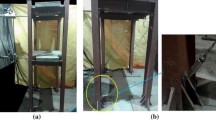Abstract
A new online hybrid test system combined with substructuring techniques and incorporating finite element methods is developed. In the proposed system, numerical substructure analysis is conducted by ABAQUS/Explicit. An ABAQUS user subroutine is used as the interface between the main control program and ABAQUS to impose the target displacements and determine the reaction forces. No iteration is needed in this system, making it suitable for physical testing. As the approach also avoids the need to modify source code, it will be appealing to a number of real engineering applications. The proposed system adopts a separated-model framework, operator-splitting integration scheme, and data exchange through a socket mechanism. The earthquake responses of a simple steel moment-resisting frame are simulated, and the results obtained from the new system are compared to those obtained from the conventional analysis. It is found that the results obtained from the new system are accurate, demonstrating the applicability and efficiency of the proposed approach. The optimal test parameters are also studied to gain the most accurate results in the minimum time.
Similar content being viewed by others
References
Takanashi K, Nakashima M. Japanese activities on on-line testing. J Eng Mech, 1987, 113:1014–1032
Shing P B, Nakashima M, Bursi O S. Application of pseudodynamic test method to structural research. Earthq Spectra, 1996, 12: 29–56
Mahin S A, Shing P B. Pseudodynamic method for seismic testing. J Struct Eng ASCE, 1985, 111: 1482–1501
Nakashima M. Development, potential, and limitations of real-time online (pseudo-dynamic) testing. Philos Trans R Soc Math Phys Eng Sci, 2001, 359: 1851–1867
Nakashima M, Masaoka N. Real-time on-line test for MDOF systems. Earthq Eng Struct Dyn, 1999, 28: 393–420
Pan P, Nakashima M, Tomofuji H. Online test using displacement-force mixed control. Earthq Eng Struct Dyn, 2005, 34: 869–888
Wang T, Yoshitake N, Pan P, et al. Numerical characteristics of peer-to-peer (P2P) internet online hybrid test system and its application to seismic simulation of SRC structure. Earthq Eng Struct Dyn, 2007, 37: 265–282
Yang Y S, Yang C T, Hsieh S H, et al. A translator approach for distributed earthquake engineering hybrid simulation across heterogeneous environments. J Chin Inst Eng, 2011, 34: 489–501
Tsai K, Hsieh S, Yang Y, et al. Network platform for structural experiment and analysis (I). Taiwan: National Center for Research on Earthquake Engineering, 2003. Report No: Report NCREE-03-021
Elkhoraibi T, Mosalam K M. Towards error-free hybrid simulation using mixed variables. Earthq Eng Struct Dyn, 2007, 36: 1497–1522
Li J, Spencer B, Elnashai A. Bayesian updating of fragility functions using hybrid simulation. J Struct Eng, 2013, 139: 1160–1171
Li J, Spencer B, Elnashai A, et al. Substructure hybrid simulation with multiple-support excitation. J Eng Mech, 2012, 138: 867–876
Wu B, Deng L, Yang X. Stability of central difference method for dynamic real-time substructure testing. Earthq Eng Struct Dyn, 2009, 38: 1649–1663
Wu B, Wang Z, Bursi O S. Actuator dynamics compensation based on upper bound delay for real-time hybrid simulation. Earthq Eng Struct Dyn, 2013, 42: 1749–1765
Zhang Y, Sause R, Ricles J M, et al. Modified predictor-corrector numerical scheme for real-time pseudo dynamic tests using state-space formulation. Earthq Eng Struct Dyn, 2005, 34: 271–288
Gao X, Castaneda N, Dyke S J. Real time hybrid simulation: from dynamic system, motion control to experimental error. Earthq Eng Struct Dyn, 2013, 42: 815–832
Chen P C, Tsai K C, Lin P Y. Real-time hybrid testing of a smart base isolation system. Earthq Eng Struct Dyn [Internet]. 2013 [cited 2013 Oct 10], Available from: http://onlinelibrary.wiley.com/doi/10.1002/eqe.2341/abstract
Chen P C, Tsai K C. Dual compensation strategy for real-time hybrid testing. Earthq Eng Struct Dyn, 2013, 42: 1–23
Shing P B, Bursi O S, Vannan M T. Pseudodynamic tests of a concentrically braced frame using substructuring techniques. J Constr Steel Res, 1994, 29: 121–148
Pegon P, Pinto A V. Pseudo-dynamic testing with substructuring at the ELSA Laboratory. Earthq Eng Struct Dyn, 2000, 29: 905–925
Magonette G. Development and application of large-scale continuous pseudo-dynamic testing techniques. Philos Trans R Soc Lond Ser Math Phys Eng Sci, 2001, 359: 1771–1799
Molina F J, Verzeletti G, Magonette G, et al. Pseudodynamic tests on rubber base isolators with numerical substructuring of the superstructure and strain-rate effect compensation. Earthq Eng Struct Dyn, 2002, 31: 1563–1582
Pan P, Tada M, Nakashima M. Online hybrid test by internet linkage of distributed test-analysis domains. Earthq Eng Struct Dyn, 2005, 34: 1407–1425
Tada M, Kuwahara S. Basic study on the system of structural analysis by unifying various programs through Internet. J Struct Constr Eng Trans AIJ, 2004, 580:113–120
Pinto A V, Pegon P, Magonette G, et al. Pseudo-dynamic testing of bridges using non-linear substructuring. Earthq Eng Struct Dyn, 2004, 33: 1125–1146
Takahashi Y, Fenves G L. Software framework for distributed experimental-computational simulation of structural systems. Earthq Eng Struct Dyn, 2006, 35: 267–291
Wang T, Nakashima M, Pan P. On-line hybrid test combining with general-purpose finite element software. Earthq Eng Struct Dyn, 2006, 35: 1471–1488
Nakashima M, Kaminosono T, Ishida M, et al. Integration techniques for substructure pseudo dynamic test. Palm Springs CA, 1990
Combescure D, Pegon P. Alpha operator splitting time integration technique for PSD testing error propagation analysis. Soil Dyn Earthq Eng, 1997, 16: 427–444
Pan P, Tomofuji H, Wang T, et al. Development of peer-to-peer (P2P) internet online hybrid test system. Earthq Eng Struct Dyn, 2006, 35: 867–890
Author information
Authors and Affiliations
Corresponding author
Rights and permissions
About this article
Cite this article
Lam, A., Pan, P. & Deng, K. Online hybrid test using a finite element program and an explicit integration scheme. Sci. China Technol. Sci. 58, 163–173 (2015). https://doi.org/10.1007/s11431-014-5734-7
Received:
Accepted:
Published:
Issue Date:
DOI: https://doi.org/10.1007/s11431-014-5734-7



